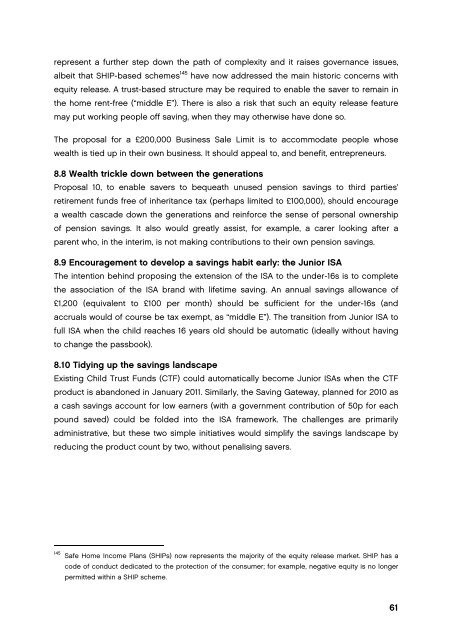Simplification is the key - Centre for Policy Studies
Simplification is the key - Centre for Policy Studies
Simplification is the key - Centre for Policy Studies
Create successful ePaper yourself
Turn your PDF publications into a flip-book with our unique Google optimized e-Paper software.
epresent a fur<strong>the</strong>r step down <strong>the</strong> path of complexity and it ra<strong>is</strong>es governance <strong>is</strong>sues,<br />
albeit that SHIP-based schemes 145 have now addressed <strong>the</strong> main h<strong>is</strong>toric concerns with<br />
equity release. A trust-based structure may be required to enable <strong>the</strong> saver to remain in<br />
<strong>the</strong> home rent-free (“middle E”). There <strong>is</strong> also a r<strong>is</strong>k that such an equity release feature<br />
may put working people off saving, when <strong>the</strong>y may o<strong>the</strong>rw<strong>is</strong>e have done so.<br />
The proposal <strong>for</strong> a £200,000 Business Sale Limit <strong>is</strong> to accommodate people whose<br />
wealth <strong>is</strong> tied up in <strong>the</strong>ir own business. It should appeal to, and benefit, entrepreneurs.<br />
8.8 Wealth trickle down between <strong>the</strong> generations<br />
Proposal 10, to enable savers to bequeath unused pension savings to third parties’<br />
retirement funds free of inheritance tax (perhaps limited to £100,000), should encourage<br />
a wealth cascade down <strong>the</strong> generations and rein<strong>for</strong>ce <strong>the</strong> sense of personal ownership<br />
of pension savings. It also would greatly ass<strong>is</strong>t, <strong>for</strong> example, a carer looking after a<br />
parent who, in <strong>the</strong> interim, <strong>is</strong> not making contributions to <strong>the</strong>ir own pension savings.<br />
8.9 Encouragement to develop a savings habit early: <strong>the</strong> Junior ISA<br />
The intention behind proposing <strong>the</strong> extension of <strong>the</strong> ISA to <strong>the</strong> under-16s <strong>is</strong> to complete<br />
<strong>the</strong> association of <strong>the</strong> ISA brand with lifetime saving. An annual savings allowance of<br />
£1,200 (equivalent to £100 per month) should be sufficient <strong>for</strong> <strong>the</strong> under-16s (and<br />
accruals would of course be tax exempt, as “middle E”). The transition from Junior ISA to<br />
full ISA when <strong>the</strong> child reaches 16 years old should be automatic (ideally without having<br />
to change <strong>the</strong> passbook).<br />
8.10 Tidying up <strong>the</strong> savings landscape<br />
Ex<strong>is</strong>ting Child Trust Funds (CTF) could automatically become Junior ISAs when <strong>the</strong> CTF<br />
product <strong>is</strong> abandoned in January 2011. Similarly, <strong>the</strong> Saving Gateway, planned <strong>for</strong> 2010 as<br />
a cash savings account <strong>for</strong> low earners (with a government contribution of 50p <strong>for</strong> each<br />
pound saved) could be folded into <strong>the</strong> ISA framework. The challenges are primarily<br />
admin<strong>is</strong>trative, but <strong>the</strong>se two simple initiatives would simplify <strong>the</strong> savings landscape by<br />
reducing <strong>the</strong> product count by two, without penal<strong>is</strong>ing savers.<br />
145 Safe Home Income Plans (SHIPs) now represents <strong>the</strong> majority of <strong>the</strong> equity release market. SHIP has a<br />
code of conduct dedicated to <strong>the</strong> protection of <strong>the</strong> consumer; <strong>for</strong> example, negative equity <strong>is</strong> no longer<br />
permitted within a SHIP scheme.<br />
61

















